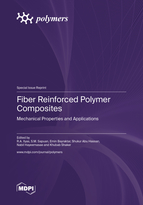Fiber Reinforced Polymer Composites: Mechanical Properties and Applications
A special issue of Polymers (ISSN 2073-4360). This special issue belongs to the section "Polymer Composites and Nanocomposites".
Deadline for manuscript submissions: closed (30 June 2023) | Viewed by 28110
Special Issue Editors
Interests: polymer engineering; material engineering; natural fibers; bio-composites; nanocomposites
Special Issues, Collections and Topics in MDPI journals
Interests: natural fibre composites; material selection; biobased packaging
Special Issues, Collections and Topics in MDPI journals
Interests: advanced manufacturing processes (sinter forging, thixoforming); damage mechanisms of materials (metallic, intermetallic, rubber and epoxy-based composites); design of new composites and damage characterization; design and manufacturing of recycled constituent composites
Special Issues, Collections and Topics in MDPI journals
Interests: composites materials; structures; composites structure durability; recycling composites; biomimetics design; composites testing; natural fibre composites; hybrid composites; composites bonding; polymer mortar composites
Special Issues, Collections and Topics in MDPI journals
Interests: rubber recycling; rubber nanocomposites; rubber products
Special Issue Information
Dear Colleagues,
Composites have been discovered to be the most promising material available in the twenty-first century. Composites reinforced with synthetic or natural fibers are becoming extremely prevalent as the market grows in demand for lightweight materials with high strength for specific applications. Not only does fiber-reinforced polymer composite have a high strength-to-weight ratio, but it also has excellent properties such as high durability, stiffness, damping property, flexural strength, and resistance to corrosion, wear, impact, and fire. Various properties of composites materials have led to applications in construction, aerospace, automobile, biomedical, marine, and many other industries. Because the performance of composite materials is primarily determined by their constituent elements and manufacturing techniques, the functional properties of various fibers available worldwide, their classifications, and the manufacturing techniques used to fabricate the composite materials must be investigated.
Dr. Rushdan Ahmad Ilyas
Prof. Dr. Salit Mohd Sapuan
Prof. Dr. Emin Bayraktar
Dr. Shukur Abu Hassan
Dr. Nabil Hayeemasae
Dr. Khubab Shaker
Guest Editors
Manuscript Submission Information
Manuscripts should be submitted online at www.mdpi.com by registering and logging in to this website. Once you are registered, click here to go to the submission form. Manuscripts can be submitted until the deadline. All submissions that pass pre-check are peer-reviewed. Accepted papers will be published continuously in the journal (as soon as accepted) and will be listed together on the special issue website. Research articles, review articles as well as short communications are invited. For planned papers, a title and short abstract (about 100 words) can be sent to the Editorial Office for announcement on this website.
Submitted manuscripts should not have been published previously, nor be under consideration for publication elsewhere (except conference proceedings papers). All manuscripts are thoroughly refereed through a single-blind peer-review process. A guide for authors and other relevant information for submission of manuscripts is available on the Instructions for Authors page. Polymers is an international peer-reviewed open access semimonthly journal published by MDPI.
Please visit the Instructions for Authors page before submitting a manuscript. The Article Processing Charge (APC) for publication in this open access journal is 2700 CHF (Swiss Francs). Submitted papers should be well formatted and use good English. Authors may use MDPI's English editing service prior to publication or during author revisions.
Keywords
- fiber
- natural fiber
- polymer
- polymer composites
- biocomposites
- mechanical properties
- green material
- sustainability material












